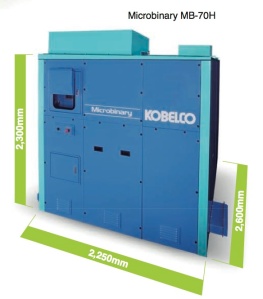New cheap and efficient micro binary power generation systems from several manufacturers to also use industrial waste heat.

Japanese onsen resorts are hot spring baths which dot the geologically active nation. Japan has over 28,000 onsen hot springs discharging more than 2.75 million liters of hot spring water goodness every minute of every day.
That’s a heck of a lot of energy potential. Unlike solar or wind, this renewable energy source is stable, consistent and can can easily replace nuclear or fossil energy if harnessed properly.
Several Japanese manufacturers are about to ship systems called Micro Binary Generators which allow electricity to be generated from this massive resource without affecting the quality of the treasured onsen baths themselves. As an additional benefit, these systems also generate power from waste heat at factories and other facilities.
The micro binary system development is being actively pushed by the Japanese government for development and the technology has already been proven. Systems will start shipping in the latter half of fiscal 2012. The systems use an air-conditioner type CFC replacement that boils at low temperatures of 70 to 100 degrees celcius or lower to drive a turbine.
One very large market for these systems is local power generation for communities to help them gain energy independence. This is a common theme now in post Fukushima Japan.
This new type of power generation technology can be considered a new form of geothermal energy as existing hot springs can be used to drive the process. Another enormous application is using industrial waste heat in combination with boilers, incinerators, generators, and numerous other processes which generate heat which not normally captured.
Kawasaki Heavy Industries, KOBELCO, and Mitsubishi are some companies that developed the technology are getting ready to ship these systems. KOBELCO has already closed some orders for these new systems.
Kawasaki is focused on 250kW micro binary systems. In tests combining high efficiency 5MW gas turbines with the new binary system, the energy efficiency has been raised to over 50%.
KOBELCO is focused on smaller 70kW and 120kW systems. The 70kW systems are expected to be priced around 40 million yen.
It’s expected that the power generated by these systems will be competitive with both fossil and nuclear system power, as well as other local plant generation systems.


That is an interesting development, and with small scale geothermal getting paid 40 yen per kWh in the feed-in tariff (plus 2 yen tax), this might take off seriously.
I was not familiar with the term “binary” in this context. It appears that refers to the fact that the system uses two different liquids, water and the lower boiling point liquid. There is a Wikipedia stub which explains that:
http://en.wikipedia.org/wiki/Binary_cycle
The committee that proposed the 40 yen tariff assumed installation cost of 1.23 million yen per kW, and wanted to achieve a high internal rate of return of 13% based on the fact that drilling is expensive, and with no success guaranteed:
Click to access 007_s01_00.pdf
So if you get a 70 kW system for 40 million yen, that would seem to beat the assumptions above by a factor of about two.
Looks like anyone getting into this business early could achieve some nice profits.
You are correct – the term “binary” refers to the use of two liquids in two separate loops in conjunction with a heat exchanger. Another name for this is the Organic Rankine cycle:
http://en.wikipedia.org/wiki/Organic_Rankine_cycle
The power generation medium is some liquid with a low boiling temperature in a closed loop. It is quite similar to running an air conditioner backwards! I remember reading somewhere about a US based town generating their power via a modified Carrier brand industrial air conditioner unit backwards to utilize relatively low temperature hot springs.
Pingback: Onsen power | Lenz Blog
Pingback: Flying Wind Turbines And Power Generating Onsen | SimplyInfo